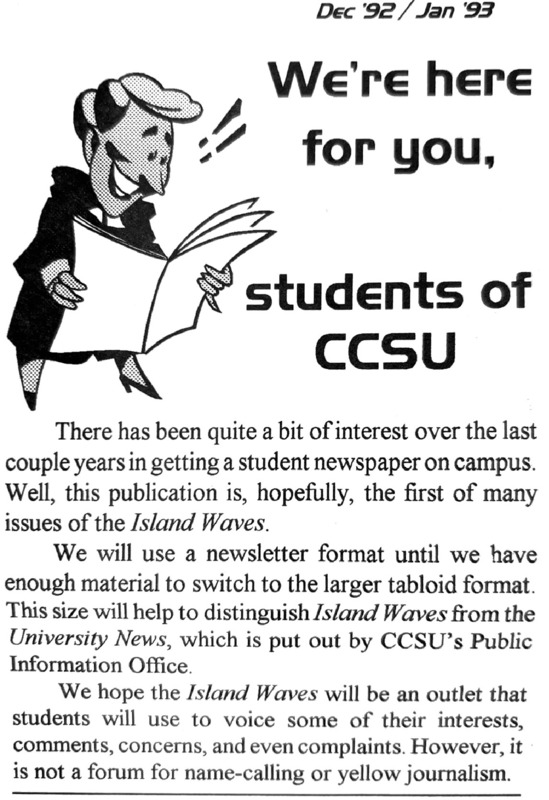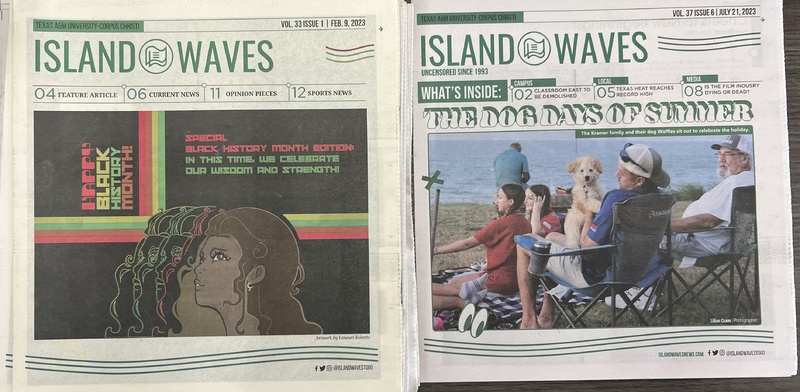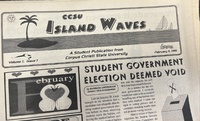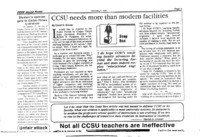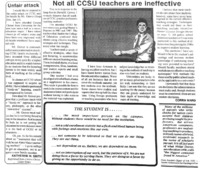Extending [un]censorship to minoritized voices: Establishing a student newspaper at Texas A&M University, Corpus Christi by Gillian Benedetti
Island Waves, the official Texas A&M University-Corpus Christi student newspaper (Student newspaper to debut soon, 1992), aimed to honor student voices through explicit announcements and requests for content since its inception (Articles needed from students, 1993; We’re here for you, students of CCSU, 1992-1993). The added subtitle of “uncensored since 1993” on the nameplate of this publication memorialized this sentiment (Island Waves, 2023, July 21, p. 1). Such emphasis also appears prominently articulated on their current website and social media platforms including Facebook, Instagram, Twitter, and YouTube (Island Waves, 2023a, 2023b, 2023c, 2023d, 2023e). Designated as a Hispanic-serving institution (Texas A&M University-Corpus Christi, n.d.), I propose extending the servingness by including Spanish-language versions of the university student newspaper as this can foster a sense of belongingness by utilizing cultural capital (Chavez, 2008; Lara & Lara, 2012) thus extending the un-censorship (Chen et al., 2021) to these individuals and groups in our community.
Student newspapers with authentic, censorship-free voices are important because they serve as platforms for promoting issues of concern that are important to students since more mainstream publications may overlook these same topics (Russo & Hapney, 2013). In the past, these minoritized groups included students and women alike; the end of censorship led to increased student presence in university governing body, and the allowing of women to smoke on campus (Garcia, 2016). The legal landscape also supported the rights of censorship-free student voices. Court cases ruled that student journalists have the right to publish without the approval of administration (Antonelli v Hammond, 1970). Later cases limited this freedom permitting censorship of school-sponsored publications if administration deem them educationally justified (Hazelwood v Kuhlmeier, 1988). Censorship can limit or essentially eliminate voices from minoritized student population (Chen et al, 2021). Research indicates that the lack of involvement can result in reduced sense of belongingness as engaging in meaningful activities can increase this feeling of belonging (Strayhorn, 2018).
The Hispanic racial and ethnic population is projected as the third fastest-growing group in the nation (US Census, 2020), and it is the largest demographic group in Texas (Ura, 2022). In city of Corpus Christi, the Hispanic population accounts for 64.3% of the total population (US Census, 2022) where 45.8% are Spanish-speaking households (USA.com, n.d.), with Spanish as the most commonly used non-English language (Stacker, n.d.). Texas A&M University- Corpus Christi has an enrollment of 49.8% of Hispanic students at the graduate level and 28.9% at the graduate level (College Factual, n.d.). With a designation as a Hispanic-serving institution (Texas A&M University-Corpus Christi, n.d.), and the university student newspaper title including the word uncensored, I propose a potential way to extend this servingness and belongingness to an exponentially growing population. One idea is to include Spanish-language versions of the university student newspaper if a plan like this does not already exist. Hispanic-serving institutions are positioned to support Hispanic students holistically, which includes the fostering of cultural wealth that Hispanic students bring (Lara & Lara, 2012). The use of cultural capital, defined as cultural knowledge, skills, and education, contributes to students’ feelings of belonging or community at the university (Chávez, 2008). Belongingness can be seen as a basic human need that impacts behaviors, including positive outcomes (Strayhorn, 2018). Existing research indicates that some Hispanic students may lack a sense of belongingness on campus due to a lack of outlets for activism (Cronin et al., 2012), so it may not be unreasonable to think that the lack of a Spanish-language, bilingual student newspaper to help uncensored voices be heard on this Hispanic-serving campus may not help in the area of belongingness. This may certainly be a missed opportunity to use cultural capital to amplify the voices of the community.
Bi-lingual newspapers can help with the sense of belongingness by taking nuanced positions of service, such as providing minorized individuals with information that they trust (Gomez-Aguinaga, et al., 2021) and find important (Chen et al., 2021). It can also serve the broader minoritized community as it provides an intentional space to share and address their unique needs, much like it did during the COVID-19 period (Bilingual student paper aids Latino community underserved by local media, 2021). Bi-lingual issues can offer venues for these receptive and expressive voices that may otherwise be lost (Chen et al., 2021) thus contributing to another layer of belongingness through these meaningful activities (Strayhorn, 2018). Lastly, this publication can provide students on the newspaper staff with service-learning opportunities to sharpen skills and students to engage in activism through these “brave spaces” for expressions and discussions of potentially conflicting points of view (Jacoby, 2017, p. 5) and become “problem solvers” (Jacoby, 2017, p. 5). These possibilities align with the research position of providing Spanish-speaking communities with space, access, and voice and everyone else with knowledge of these otherwise diminished voices (Salinas, 2017). The lack of diversity and opportunities may also impact the pathway for a career. The lack of such a pathway can lead to underrepresentation and oversight of information (Chen et al., 2021). To me, it speaks to an unintended censorship, such as the previously mentioned voice limitation and elimination, despite its newly added namesake of “Uncensored since 1993.”
As evident, the direction in which the newspaper continues without bilingual issues may unintentionally extend censorship thus removing a sense of belongingness. Therefore, I propose the addition of Spanish-language student issues of the university student newspaper publication. While other universities in the USA have already adapted this bi-lingual approach to student news publishing, including California State University-Bakersfield, De Paul University, and Midwestern State University (The Runner en Español, n.d.; The DePaulia, n.d.; The Wichitans, n.d.), this effort may be met with challenges associated with changes like this since many elements are involved. Scholars, practitioners, students, and the community are each “actors” (Weaver-Hightower, 2008, p. 156) in their own rights and may exist within complex “relationships” (Weaver-Hightower, 2008, p. 156) among and in relation to each other. These actors and relationships are influenced by the “environments” and “structures” in which they exist (Weaver-Hightower, 2008, p. 156), and the “processes” (Weaver-Hightower, 2008, p. 156) depend on the changes that occur between the above-quoted elements.
Each actor may have their unique roles in this effort of having Bilingual, Spanish-language student newspaper issues on this campus. To start, here are some preliminary ideas. Researchers can gather data on the exact nature of servingness, find out the desires and needs of the groups, research existing best practices, and apply for grant-funding opportunities to realize this endeavor. Practitioners can also apply for grant-funding opportunities, research and develop policies, and administrators can rethink leadership (Gracia, 2023) provide pathways for involving faculty and staff who are Hispanic (Garcia, 2016), and allow for infrastructure (Garcia, 2023) like counter spaces and revisiting the strategic plan to ensure the success of this effort. Collaboration with existing programs such as TRIO and Student Life can potentially help with the (re)building and maintenance of this intentional effort; collaboration with students, such as through advising and a mentorship program, can potentially help with the student connection. Students can engage in platicas allowing a personal cultural understanding (Madrigal, 2023), provide insights on the nature of servingness along with their needs, partake in feedback of the plans, advocate for student buy-in of the bilingual newspaper, and partake in the development of the newspaper. Much like students, communities can also provide insights and feedback. They can also be advocates for promoting agency, as support from the local community is crucial for maximizing growth (Torres, 2012). The Instituto de Cultura Hispanica de Corpus Christi (n.d.) which has a vested interest in education and scholarship at the university, can be one of the identified entities to deepen a mutually beneficial relationship. Among the actors, there may also be opportunities for “involvement,” as defined as the act of doing, and “engagement,” as defined as purposefully spending time and energy (Strayhorn, 2018, p. 143), such as faculty connecting with students to build a sense of belonging (Strayhorn, 2018).
In summary, while there are “niches and roles” (Garcia, 2016, p. 166), multiple roles may exist among these “actors” (Weaver-Hightower, 2008, p. 156) and there may be “redundancy” (Garcia, 2016, p. 167) in the processes (Weaver-Hightower, 2008, p. 156). One of ideas’ aim is to foster a “relationship” (Weaver-Hightower, 2008, p. 156) of “cooperation” (Garcia, 2016, p. 166) between actors where everyone works together to accomplish this mutual goal (Garcia, 2016). Another aim of the ideas is to plan for sufficient “input” of resources available for all (Garcia, 2016, p. 166) with an “emergence” (Garcia, 2016, p. 166) process where resources and actors are sustained. Lastly, the plan is for smooth “adaptation” (Garcia, 2016, p. 167) where actors align themselves with these changes. Changes like this may not occur overnight as adjustments to communication, skills, procedures, policies, and structures undergo transition phases before moving forward in the process (Lewin, 1947). Perhaps we can start with strengthening the existing relationships between actors and groups and continue those proverbial hallway conversations to build on this effort As a Hispanic-serving institution, it is our responsibility to extend servingness and belongingness, such as by including Spanish-language versions of our university student newspaper. We need to foster belongingness and support cultural wealth to empower the “voces pertitas”... the lost voices (Salinas, 2017, p. 747).
Special thank you to:
Dr. Kevin Bazner, Amanda Kowalski, Amanda King, Dr. Lori Podolsky, TAMU-CC ArchivesMiranda Martinez, EDLD 6306 Higher Education in a Democratic Society, & EDLD 6390 Hispanic Serving Institutions peers

